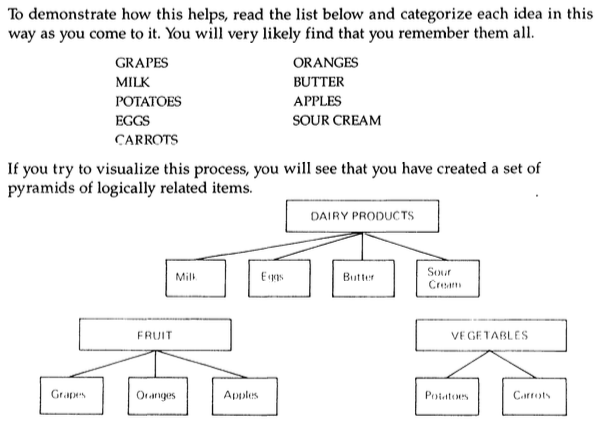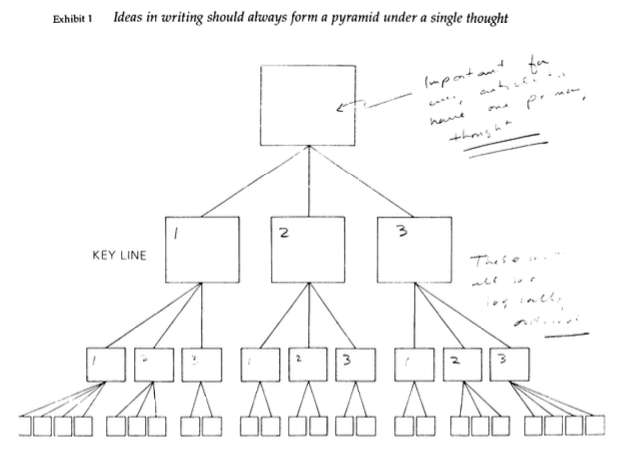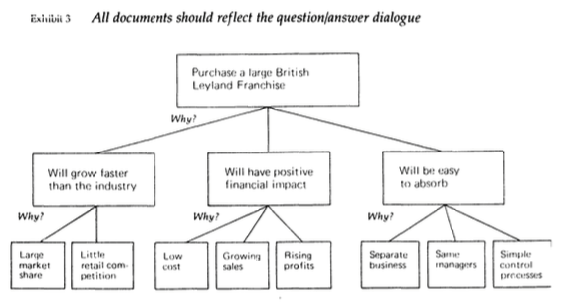The Minto Pyramid Principle - Barbara Minto
Book Info 📚
- Author: [[ Barbara Minto ]]
- Related: Read [[ McKinsey ]]
Quote 💡
Summary 💬
- Sắp xếp các ý tưởng để trình bày theo cấu trúc kim tự tháp
- Ý tưởng ở bất kỳ cấp nào của kim tự tháp là tóm tắt của các ý bên dưới (giải thích cho nó)
- Các ý tưởng cùng cấp phải cùng loại (category)
- Các ý tưởng phải được sắp xếp theo trật tự một cách logic
- Có 4 cách để sắp xếp thứ tự ý tưởng
- Lối diễn giải: Luận điểm, dẫn chứng, kết luận
- Thứ tự thời gian: Thứ nhất, thứ hai
- Cấu trúc (các thành phần): Miền Bắc, Miền Trung, Miền Nam (vùng địa lý)
- So sánh: Quan trọng nhất, quan trọng nhì (mức độ quan trọng)
- Trình bày ý tưởng cần quan tâm đến mối quan hệ hàng dọc (vertical) và hàng ngang (horizontal)
Highlights 📒
PART 1: LOGIC IN WRITING
1. WHY A PYRAMID STRUCTURE
SORTING INTO PYRAMIDS

The Need to State the Logic
Now clearly, it is not enough simply to group the ideas in a logical way without also stating to yourself what the logic of the relationship is. The point in grouping was not just to move from a set of nine items to separate sets of four, two, and three items. That still comes to nine. What you want to do is move above the nine, to three.
This means that instead of remembering each of the nine items, you remember only the three categories into which they fal1. You are thinking one level of abstraction higher, but because the thought is at a higher level, it suggests the items below it. And, because the relationship is not a contrived one as was the case in the exercise about the lake and the sugar, it is much easier to keep in mind.
ORDERING FROM THE TOP DOWN
The clearest sequence is always to give the summarizing idea before you give the individual ideas being summarized. 1 cannot emphasize this point too much.
I have given you a piece of information, and without realizing it you will automatically make some assumptions about the reason for my giving you that inforrnation.
==The reader is always going to look for a structure connecting the ideas as they come to him. To make sure he finds the one you intended, you must tell him in advance what it is-to make sure he knows what to look for.== Otherwise he is likely either to see an unintended relationship, or worse, none at a11, in which case you have both wasted your time.
💡 Present the idea using the top-down approach (pyramid structure) even the content has been prepared in the bottom-up manner.
THINKING FROM THE BOTTOM UP
If you think for a moment about what you actua11y do when you write, you can see that you develop your major ideas by thinking in this bottom-up manner. At the very lowest level in the pyramid, you group together sentences, each containing an individual idea, into paragraphs.
3 rules:
- Ideas at any level in the pyramid must always be summaries of the ideas grouped below them.
- Ideas in each grouping must always be the same kind of idea.
- Ideas in each grouping must always be logically ordered.
P10

Essentially it says that there are only four possible logical ways in which to order a set of ideas:
- Deductively (major premise, minor premise, conclusion)
- Chronologically (first, second, third)
- Structurally (Boston, New York, Washington)
- Comparatively (first most important, second most important, etc.)
2. THE SUBSTRUCTURES WITHIN THE PYRAMID
THE VERTICAL RELATIONSHIP
The vertical relationship serves marvelously to help capture the reader’s attention. It permits you to set up a question/answer dialogue that will pull him with great interest through your reasoning. Why can we be so sure the reader will be inter- ested? Because he will be forced to respond logically to your ideas.
Since people do not generally read to find out what they already know, it is fair to state that your primary purpose in communicating your thinking will always be to tell people what they do not know.

THE HORIZONTAL RELATIONSHIP A deductive grouping ,represents an argument in successive steps. That is, the first idea makes a statement about a situation that exists in the world today. The second idea comments on the subject or the predicate of that statement, and the third idea states the implication of those two situations existing in the world at the same tin1e. Thus, the grouping would have the following form:
- Menaremortal.
- Socrates isaman.
- Therefore Socrates is mortal. => Summary: “Because Socrates is a man he is mortal.””
An inductive grouping, by contrast, wiI take a set of ideas that are related simply by virtue of the fact that you can describe them all by the same plural noun (reasons for, reasons against, steps, problems, etc.). The form of this argument would be:
- French tanks are at the Polish border.
- German tanks are at the Polish border.
- Russian tanks are at the Polish border. => your inference would be something like “Poland is about to be invaded by tanks.”
THE INTRODUCTORY FLOW
Since this history will be in the form of a narrative of events, it should follow the classic narrative pattern of developrnent. That is, it should begin by ==establishing for the reader the time and place of a Situation. In that Situation something will have occurred (known as the Complication) that caused hirn to raise (or would cause him to raise) the Question to which your document will give him the Answer.==
This classic pattern of Storytelling Situation, Complication , Questions. Answer - perrnits you to make sure that you and the reader are “standing in the same place” before you take him by the hand and lead him through your reasoning.